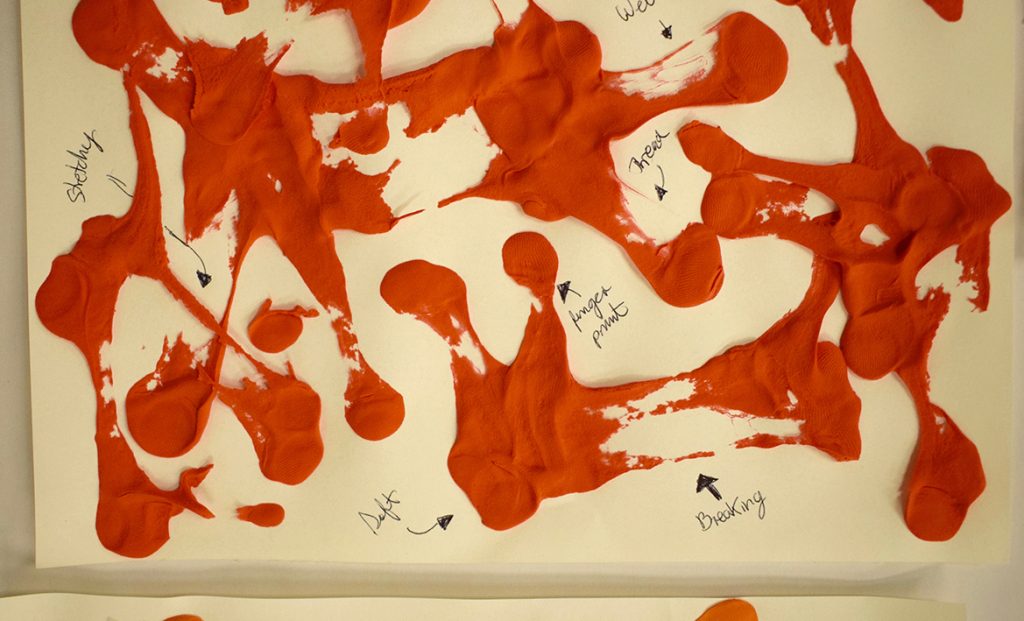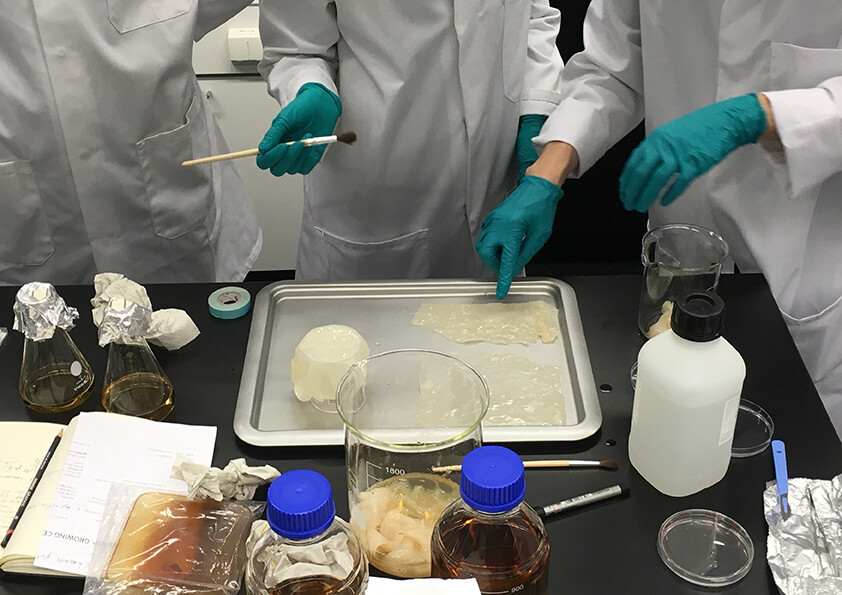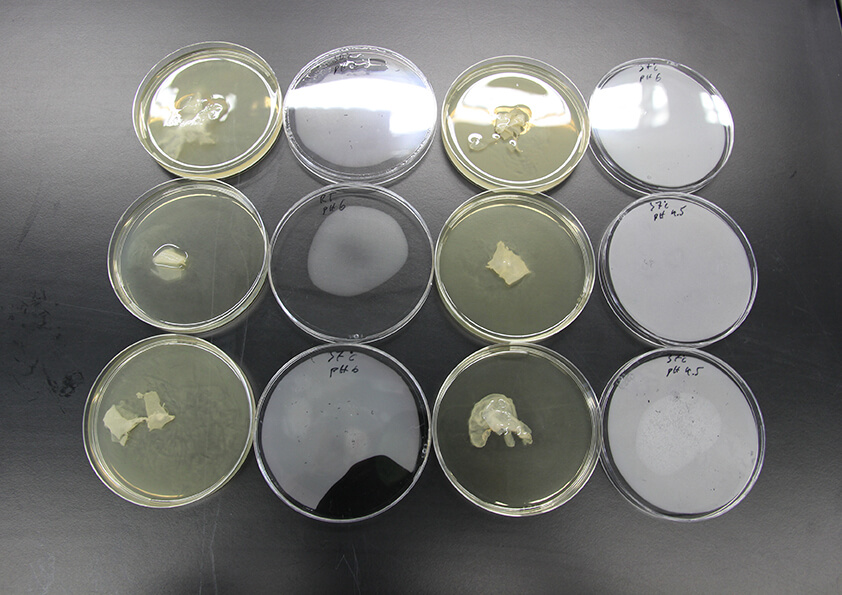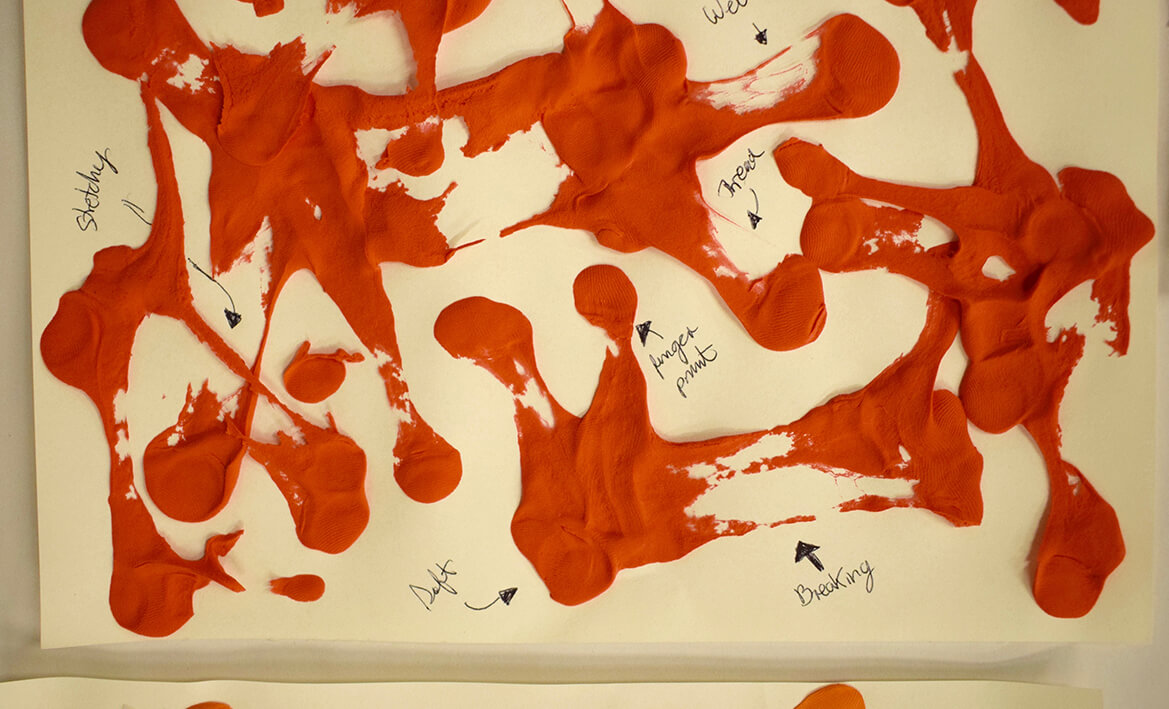Text by Kirsi Niinimäki, Camilla Groth & Pirjo Kääriäinen

New Silk is a 4-year material research project conducted at Aalto University aiming to produce new silk-like materials in synthetic biology. The project is inspired by how spiders produce their cobweb – a material with properties surpassing existing synthetic materials. The New Silk project combines the knowledge of the production of silk proteins with skills in polymer processing and the creative perspective of designers. The aim is to open a new interdisciplinary research path and to lay the foundation for this type of materials design, to be able to envision materials of the far future. The design research component in New Silk aims to construct new knowledge through an experimental approach during early-stage fundamental materials research. This text focuses on moments where people from different disciplines collaborate in an experimental workshop setting.
New relationships with materials
Materials research is attracting new attention, not least from an art and design point of view. Artists and designers have increasingly started to explore and experiment with bio-materials in the purpose of creating their own materials. These materials are usually either new combinations of existing materials or attempts to grow new materials that in one way or another “create” themselves. New materials that have a biological existence behave in unexpected ways. They can be controlled by the creator to a certain extent, but the material also displays a will of its own. With these materials, the explorative approach is the only possible route until the creator gains enough experience to start controlling the material and design a use for it.
The emerging interest in materials research and new ways of designing with materials have raised philosophical discussions on materials and their use. We are used to think of materials as resources that we master and utilize for our own purposes; we are able to control our material environment since we have the intelligence, power and skills to do so. However, recently this hierarchy has been questioned in the critique of the Anthropocene by several artists.
Experimental interdisciplinary approach
As part of recent general developments within materials research, multi- or even interdisciplinary collaboration is becoming more common. In multidisciplinary collaboration, partners stay in their own disciplinary knowledge areas but in interdisciplinary collaboration, real knowledge sharing is happening. Artists, designers and design researchers are increasingly invited to help materials researchers develop attributes of bio-based materials or find suitable application sectors for these new materials. Biological production of materials is expected to be one of the key enablers of the future bio-economy, and here artists and designers have the possibility to play a key role.
Designers’ processes are constructive, as knowledge is literally created through a building of concepts and experimenting with existing materials to design a product. Designers are thus used to uncertainty in the process and suspending anchoring the solution too early as this often aids in developing concepts further, reaching more developed and sophisticated results. Although scientists do have other traditions for their research processes, in the development of new materials, they are confronted with the unknown, with unexpected behaviour from the side of the materials.
We can only make predictions about new materials through our past experiences with them or with similar materials; therefore, intensive material exploration is the route to constructing knowledge in this context. Interaction with materials may make our understanding of the processes grounded with chemistry, biology or even physics. Such a position forces the intersection of disciplines that have the potential to construct knowledge together, knowledge that would not be possible to achieve within the separate disciplines alone.


Research through design interventions
We conducted two design interventions through interdisciplinary workshops. The first workshop had 23 participants: twelve design students, two chemistry students, eight researchers from material sciences and one design researcher. The main aims of the workshop were to familiarise the scientists with the designers’ mindset, and vice versa, and to observe how designers embrace synthetic biology without previous knowledge. The secondary aim was to gain understanding of what kind of collaborative activities would make sense in this research context.
The workshop consisted of short presentations and individual and team assignments, including a hands-on experiment with modelling clay. Participants were asked How these molecules work and how does this behaviour happen? What future applications of these materials could they envision, e.g. adhesives, fibers? The participants listed potential applications for the material based on the properties of the materials that they tested. They also played with different scales (nano-micro-human scale) and created conceptual design ideas for possible future application areas.
During the workshops, the participants also reflected on ways of collaboration over the borders of their disciplines. They also talked about their differences in approach and the challenge of sharing knowledge. Some participants commented on the different “forms” of knowledge that was constructed, others appreciated the possibility of taking time and exploring materials with people from different background:
It has been really interesting to hear/talk to people doing something completely different.
I got to know a new material, some of its properties. It also inspires me a lot and brings back my creativity.
The second workshop was organized for the research consortium, consisting of two designers and seven material scientists. The two-day workshop took place in Biofilia, a bio-art lab in Aalto University, and it was organized by the bio-artist, Margherita Pevere. The topic was to explore microbial cellulose growth in the art context. The main aims were to familiarize scientists with artists’ working methods and explore potential touchpoints between art and material science.
This workshop consisted of presentations, discussions and practical work with microbial cellulose, which was selected as an exemplary material for this workshop. The participants familiarized themselves with the microbial cellulose through a hands-on bodily experience of touching and feeling – at first blindfolded. Through this enhanced physical experience of the material the team was made aware of its properties, and this made a strong impression on them regardless of discipline: It had the same texture as the human body, skin or flesh’, said one of the designers. ‘I had a strong feeling of leather, like touching a horse’, said one of the scientists. ‘It was disgusting, I had a very strong association of the material being alive’, said another designer. The material being alive and active raised intense discussion on research ethics, artificial food, mimicking flesh and taking care of the material. One of the designers said: ‘I felt that I have to take care of it and warm it.
Philosophical discussions about research ethics continued. Is the material alive? If the material is alive, does it have a will? Does it have agency? Are we allowed to study this material? There were no clear answers, but the opportunity to discuss these topics in an interdisciplinary team was eye-opening. Discussions between people from different disciplines, learning about bio-art and bacterial cellulose, and art + science interaction were mentioned as the most interesting experiences. One of the scientists said, The most interesting and probably most valuable [thing] was the glimpse into a completely different perspective of materials and science in general.
As the strong tactile experiences created emotional associations of the material being alive and lead to discussions on research ethics, if the material is alive and has a sort of “will of its own, ” what are we allowed to do with it? Can we modify it? Do we have a right to design it? These associations take the designer closer to genetic engineering. The question of material agency in these experimentations pointed towards future research paths to follow. What are the ethical issues regarding synthetic biology, and how should designers and scientists deal with them?
Ashby and Johnson (2002) point out that all materials have intrinsic qualities, but some are easier to identify than others. They argue that it is the designer’s ability to demonstrate these qualities in the product design phase. In the future, this will be part of the designers’ work while designing intrinsic qualities for new materials. In this development, engaging more deeply in understanding perceived material affordances will be important, especially when designing with engineered materials. Perhaps, in the future, we must learn to ‘negotiate’ with these newly engineered materials and their ‘will’ or behaviour.
By combining design-specific and scientific knowledge, it will be possible to create new materials that include not only technical attributes, but also strongly aesthetic and sensorial material qualities. These first workshops were mainly a starting point for a series of shared actions to come. As one of the scientists noted:
Research is a process that takes a lot of time and the possible uses of the new materials in “real” life can take many years. Therefore the experimental collaboration continues.






